Within the span of roughly two weeks, two of Europe’s most exalted fashion houses will have landed in Seoul for high-profile runway shows.
LVMH powerhouse Louis Vuitton partnered with the Korea Tourism Organization and Squid Game director Hwang Dong-hyuk to showcase its Pre-Fall 2023 womenswear collection in the South Korean capital on April 29. And on May 16, rival luxury brand Gucci will present its Cruise 2024 collection at the city’s Gyeongbokgung Palace, kicking off a partnership with the historical edifice’s conservation body.
Today’s destination fashion shows — be it the Seoul presentations, Dior’s Pre-Fall 2023 show in India, the upcoming Cruise 2024 show in Mexico City, Chanel’s Métiers d’Art 2023 outing in Senegal, or the Cruise 2024 presentation in Los Angeles — are about far more than showing clothes against a colorful backdrop.
They are an opportunity for luxury brands to use runway shows for cultural diplomacy, whether that’s by deepening ties with local markets or investing in regions outside typical luxury fashion locations — if they can do so in a passably authentic and respectful way, that is.
The ‘glocalization’ of luxury
Staging fashion shows in far-flung locales is a longstanding tactic for luxury brands that possess the requisite cash and clout. The late Karl Lagerfeld was especially prolific in that regard, staging Fendi’s Spring/Summer 2008 collection at the Great Wall of China, Chanel’s Cruise 2017 show in Havana, Cuba, and even taking a Chanel runway to Seoul back in 2015.
“Luxury nowadays is a global market,” says Mario Ortelli, managing partner of Ortelli&Co, a strategy and M&A advisory company that focuses on the luxury sector.
The choice of where to stage a show outside the big fashion week cities of Paris, Milan, New York and London is as much about finding a stunning backdrop as it is about connecting with international customers. In that regard, Seoul fits the bill.
“South Korea is a global cultural powerhouse,” says Kyuhee Baik, a Seoul-based member of Supreme’s global brand team who is helping lead the label’s expansion in Asia.
That translates both into soft power, like the popularity of K-pop sensations such as Blackpink or BTS, and financial clout, like South Korean cosmetic giant Amorepacific’s acquisition of Vermont-founded natural beauty brand Tata Harper last fall.
“As Korean culture becomes commonplace across households worldwide, it only makes sense for Western brands to engage,” Baik added.
Risky business
But brands also need to be careful not to parachute into a locale with which they have no connection.
“This is all about my vision of Cuba. But of course, what do I know about Cuba? It is very childish, my idea,” Lagerfeld told The Cut with his trademark bluntness at his 2016 Cuba Chanel show. Today’s brands and creative directors need to show not only sensitivity but authentic connections to their host destinations.

Karl Lagerfeld presented his Cruise 2016/17 collection for Chanel in Havana, Cuba. Photo: Chanel
Two risks are offending, or being out of tune with local sensitivities. “So you have to be very careful,” says Ortelli. “If you do it wrong, it can be seen as cultural appropriation.”
It’s not just traditional luxury brands weighing the value of presenting in foreign destinations. In February this year, Canadian outdoors brand Arc’Teryx staged a presentation in China’s Yunnan Province, which sits at the border of Tibet. The event was largely unpromoted in Western media, however, perhaps to avoid a potential blowback to images showing a Western mountaineering brand utilizing traditional Tibetan culture to sell its products.
Perhaps the most high-profile example of cultural offense in recent years was the scandal surrounding Dolce & Gabbana’s 2018 Shanghai show, which was canceled after a disastrously received ad campaign.
Brands have learned their lesson; Dior’s recent womenswear show in Mumbai, India, highlighted the maison’s partnerships with local artisans, while Chanel’s runway show in Dakar, Senegal in December last year came on the heels of the city’s own fashion week and kicked off an initiative by Chanel to invest in local embroiderers and craftspeople.

Maria Grazia Chiuri’s Pre-Fall show for Christian Dior in March 2023 highlighted the craftsmanship of Indian artisans. Photo: Dior
Meanwhile, Dior’s cruise show in Mexico City on May 20 promises to “highlight the artistry and some of the emblematic figures of this country that has been dear to Dior’s heart since the beginning of the House in 1947,” the press release reads.
The benefits of the runway must, in other words, be a two-way street. “Ideally, the brand and host city should benefit from a continuing exchange of culture and commerce,” says Baik.
Seoul designers could benefit from an outside boost, she notes, given that Seoul Fashion Week is a fairly conservative, government-funded affair that doesn’t attract the influential buyers who frequent the European fashion capitals.
“These shows [like Louis Vuitton and Gucci] provide opportunities for local brands and designers to network with the international community and essentially open more means for exchanges,” says Baik. However, the spectacle of such shows also risks positioning emerging luxury markets like Seoul as an exotic “other.”
Intercultural sensitivity
“The rhetoric of ‘luxury’ as we know it today is a Western construct,” says Baik. “Staging these shows outside of their normal capitals is a novelty — almost (at its worst) like a nicely gift-wrapped ‘now you’re good enough.’”
In addition to cultural sensitivities, Ortelli emphasizes that brands must be aware of the carbon footprint they leave behind when they jet editors and personalities around the globe for a single evening.
French label Jacquemus faced criticism for hosting its Fall/Winter 2022 in Hawaii, when the state had been reeling from COVID-19 surges and some residents had urged tourists not to visit. The brand maintained that it had focused on inviting local VIPs and closely followed safety protocols.
Western brands don’t always need to go intercontinental for an “exotic” backdrop. Even before COVID-19 made international travel prohibitive, Jacquemus went to Provence to stage a memorable Spring/Summer 2020 show against the backdrop of rolling hills of lavender.

Jacquemus’ Spring 2022 show in Hawaii was the designer’s first show staged outside of France. Photo: Jacquemus
The increasingly frequent spectacle of destination shows is also an acknowledgement that runways are no longer simply industry events where editors and buyers convene to see next season’s wares. They are a marketing opportunity to create high-profile images intended to spread across social media and make waves for years to come.
However, that also requires brands to go bigger and bolder each year: Dior stepped up to this challenge with its men’s Pre-Fall collection 2023 shown in Egypt against the backdrop of Giza’s Great Pyramid. The show was perhaps more a nod to the stylings of Dune than anything connected to Egyptian heritage.
Wherever the location and whatever the initiative behind a fashion show, the spectacle needs to be worth the trouble. “The bar has got a lot higher,” says Ortelli.









